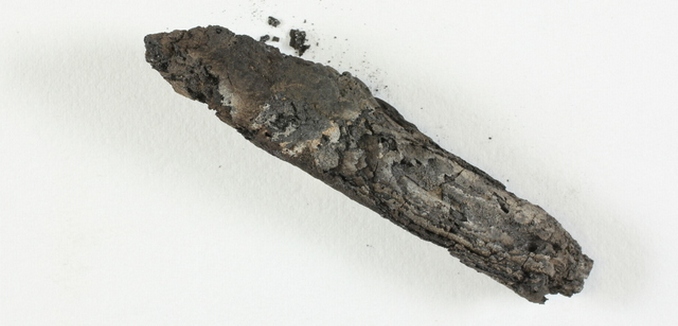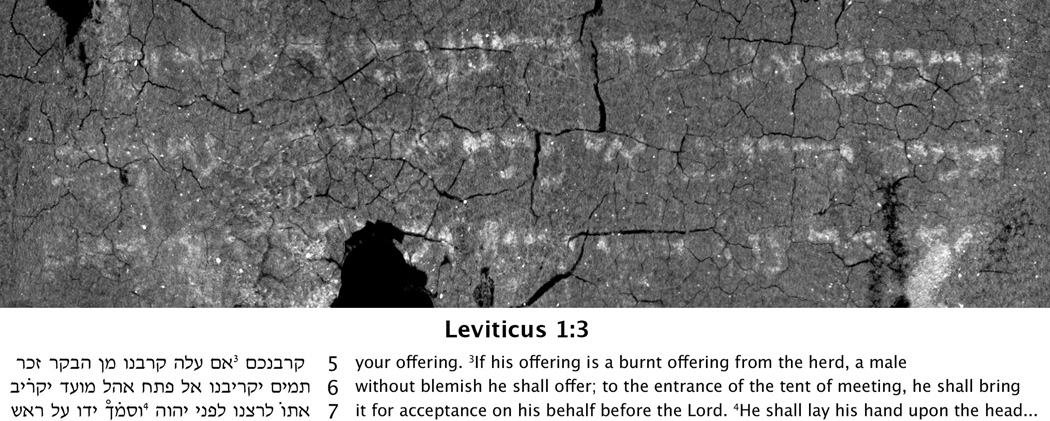Scientists who analyzed the text on an ancient, charred scroll first discovered in Israel in 1970 have found that it contains the earliest known copy of biblical scriptures in standardized form, National Geographic reported Wednesday.
The study of the scroll, which contains a section of the biblical book of Leviticus, was led by Brent Seales, chairman of the department of computer science at the University of Kentucky, who specializes in using technology to restore damaged texts. Seales and his team reconstructed the text without actually handling the burnt parchment, instead using scans of the Ein Gedi Scroll that had been sent to him by Israel Antiquities Authority in order to virtually unwrap it.
“The Ein Gedi Scroll is proof positive that we can potentially recover the whole text from damaged material, not just a few letters or a speculative word,” Seales said of his team’s accomplishment.
Carbon dating indicates that the scroll is between 17 and 18 centuries old, 500 years older than previously thought.
The scroll’s age places it between the older Dead Sea Scrolls and the more recent texts found in the Cairo Geniza, meaning that “the Ein Gedi Scroll bridges a centuries-wide gap in the history of biblical text,” National Geographic wrote.
“I think we can safely say that since the completion of the publication of the Corpus of Dead Sea Scrolls about a decade ago … the Ein Gedi Leviticus Scroll is the most extensive and significant biblical text from antiquity that has come to light,” said Michael Segal, a biblical scholar at the Hebrew University of Jerusalem and co-author of the study.
“There are clear signs of continuity of tradition,” said Emanuel Tov, another Hebrew University biblical scholar and study co-author. “It can’t be coincidental that the synagogue in Ein Gedi that was burned in the sixth century housed an early scroll whose text was completely identical with medieval texts. The same central stream of Judaism that used this Levitical scroll in one of the early centuries of our era was to continue using it until the late Middle Ages when printing was invented.”
He told the Associated Press that the text found in the Ein Gedi Scroll is “100 percent identical” to that used in Leviticus for centuries. “This is quite amazing for us,” he said. “In 2,000 years, this text has not changed.”
Not all ancient damaged parchments will be able to be recovered as easily. The Ein Gedi Scroll was written in a metal- or lead-based ink, making the letters denser and easier to detect. A carbon-based ink would be more difficult to detect because it wouldn’t be as distinct on carbonized surfaces.
Pnina Shor, head of the Dead Sea Scrolls Project at the Israel Antiquities Authority, told the Los Angeles Times that she didn’t initially believe that the scroll could be reconstructed. “The discovery of the text in the En-Gedi scroll absolutely astonished us,” she said.
“The scan we sent him looked like charcoal. When this came back as a written piece of flattened material that looked like a poem, you can’t imagine the joy in the lab. It was unbelievable,” Shor added.
The Times explained that the discovery makes “it the earliest copy of one of the five books of Moses to be discovered in a Holy Ark.” According to Segal, the text in the Ein Gedi Scroll is identical to the traditional Masoratic text, meaning it hasn’t changed in nearly 2,000 years.
The video embedded below explains the process by which the scientists were able to recover the text.
[Photo: Israel Antiquities Authority שי הלוי / WikiCommons ]






